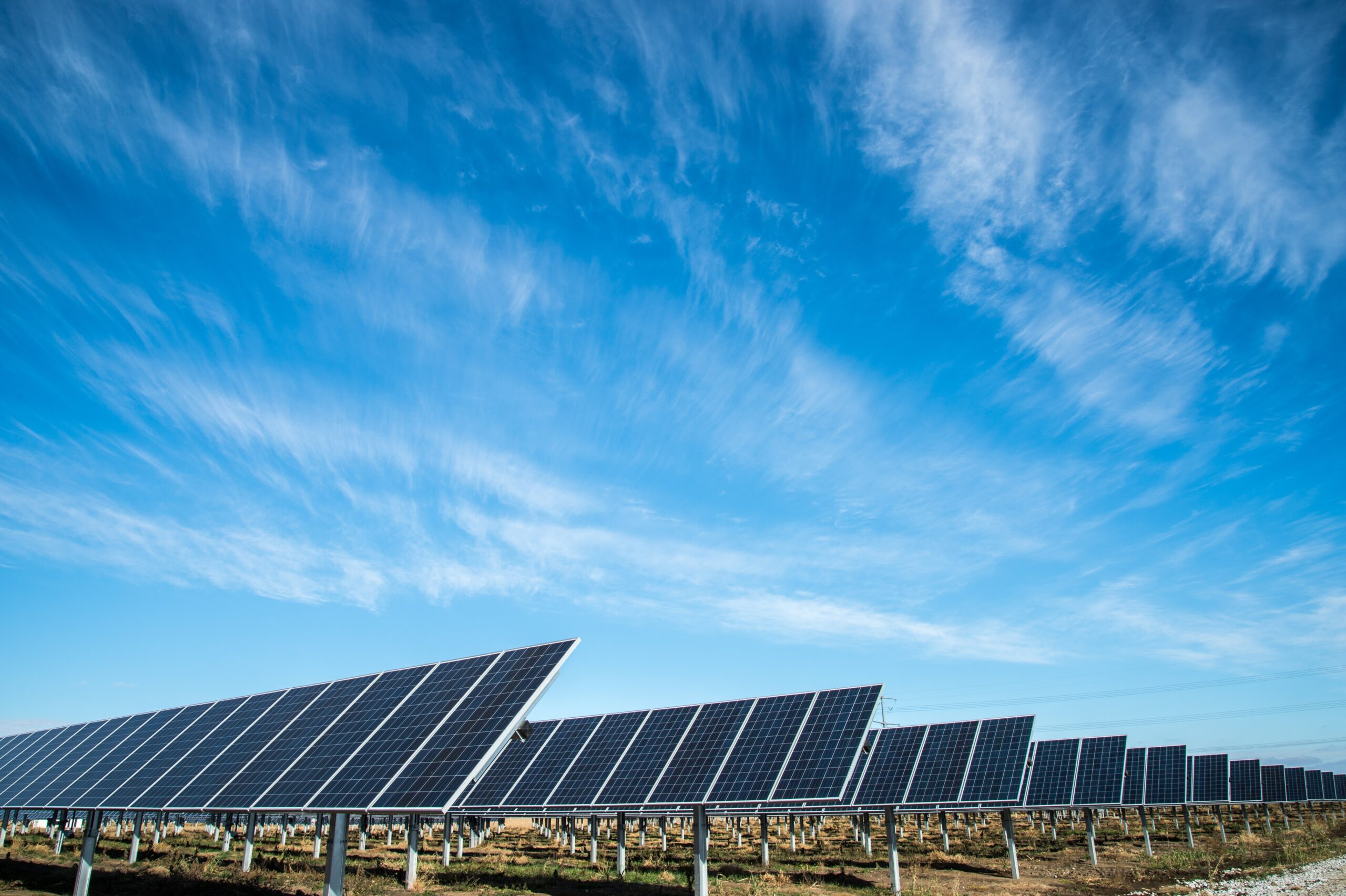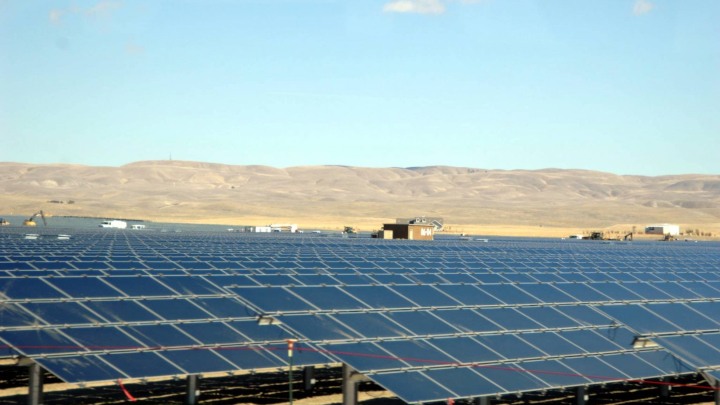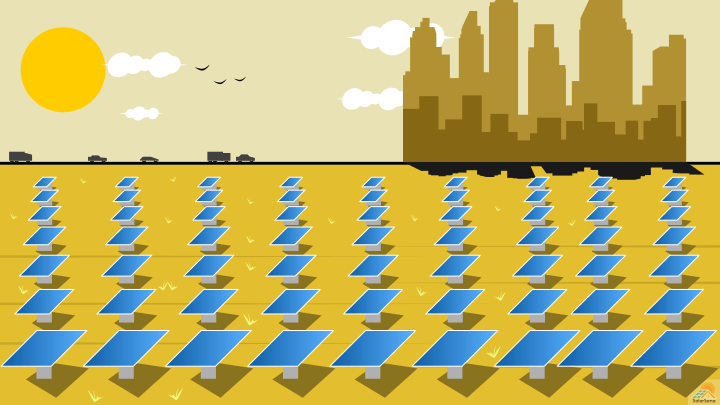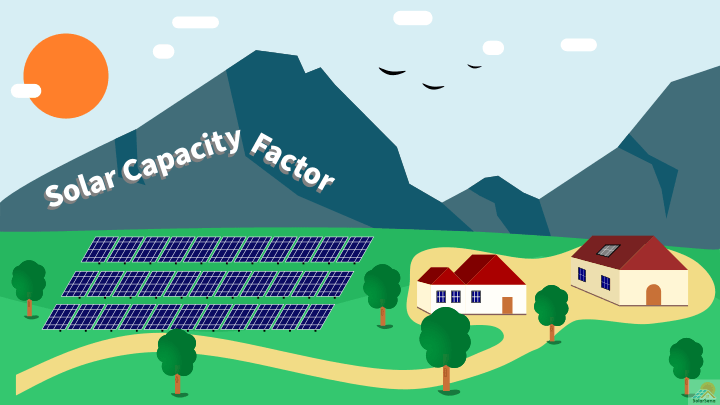As climate change continues to impact our planet and all of our lives, alternative sources of renewable energy like solar power have become increasingly important. Many homeowners have opted to place solar panels on their roof in order to reduce their energy emissions and save money. But another growing contributor to rising rates of solar power production are large solar farms, which produce solar power on a vast scale. Whether you’re exploring adding a solar farm to your land, considering leasing acres to a solar development company, or are just a solar enthusiast, it’s important to understand how much money a solar farm can make, as well a solar farm’s total ROI.
What Is a Solar Farm?
A solar farm is a purpose-built array of solar panels which is installed to generate solar power. While solar farms can vary greatly in size and total power production, they all share some core characteristics. For one, they are ideally built in areas that are flat, receive lots of direct sunlight, and which do not have obstructions like trees or hills nearby. Second, they are angled correctly depending on their unique location to ensure maximum sun penetration. Finally, they require fairly significant upfront investment, as the cost of not only the solar panels, but also inverters and other infrastructure must be considered.
Cost for A Solar Farm
Solar farms can be expensive to set up, and they can also take some time to get permitting, install, and connect with the power grid. As with most solar projects, cost calculations center around the cost per watt. While this cost will vary depending on the specifics of the solar farm project, a reasonable range would be around $1/watt, give or take $0.20 cents. So you can expect it to cost anywhere from $0.80 – $1.20 or more per watt for a large solar farm installation. As a note, this is fairly significantly less expensive than residential solar installations, because solar farms benefit from economies of scale and bulk purchasing rates.
These are not the only costs associated with a solar farm. You’ll need to install inverters and other equipment which will allow you to connect into and supply the power grid. You’ll need to cover the costs of installation labor, and also pay for ongoing maintenance and upkeep.
How Do Solar Farms Make Money?
Solar farms make money by generating power which is then sold onto the energy market. By producing and selling this solar power, the owners of the solar farm derive profits.
The other way solar farms make money is for landowners who lease out their land to solar farm operators and developers. This is a more passive way for those who are land-rich, but not solar experts, to profit from a solar farm.
How Much Money Do Solar Farms Make?
Understanding how much money a solar farm might make requires an understanding of several different variables: power production, power sale rates, and expenses.
Power Production
The total power generation of a solar farm is obviously connected to the number of solar panels installed in the solar farm. For reference, in one standard acre with an optimal set up with just under 2000 solar panels, you could produce about 0.25 MW in total. This is a baseline for your power production.
Power Sale Rates
The rate at which you can sell this power onto the electricity grid depends on your location, market conditions, and many other factors. That said, a general baseline that is commonly used is the Renewable PPA. These power purchase agreements essentially dictate the rates that the solar farms who produce the electricity will sell into the grid. For North America, “”the market average for solar PPA offers rose 5.7% to $34.25 per MWh” for Q1 2022. This is up from the previous period, and will likely grow further into 2022 given increased demand with reduced oil and gas supplies globally.
So for these baseline calculations, you might expect around $34 per MWh for your power sales.
Expenses
Expenses include the cost of your solar panels, inverters, installation, upkeep, labor for all of that, and more. Baseline expectations should hover around ½ million dollars an acre. That means a 1MW solar power farm could easily run you more than $2 million in start-up costs.
When you look at all these variables, you can better understand the true return on investment for a solar farm.
Example – Return of Investment on a 1 Megawatt Solar Farm
Let’s say you want to build a 1MW solar farm on 4 acres of land you already own, but want to first understand the total return on investment you might be able to produce.
Well, as discussed earlier your start-up costs will run you $2-3 million. Let’s call it $2.5 million, and cut it down the middle.
On those 4 acres of land, you put 8000 solar panels. In total, we can estimate that a 1MW system can generate about 1.5 million kWh a year based on optimal set-up and peak sun estimates. At a power sale rate of $34 per MWh per the PPA averages, you would have:
$34 x 1500 MWh = $51000
At that run-rate, it’d take you 49 years to cover the $2.5 million cost of set-up.
Return of Investment on Solar Farm Analysis and Other Variables
So, does that mean solar farms are bad business ventures? Well, not exactly. A 1MW farm may not be as viable, but solar farms are dynamic cost businesses in some ways, and fixed cost in others. Yes, a larger farm of say 10MW might cost more for the solar panels, but there are savings to be had in installation, labor, and other equipment. As the size of the solar farm grows, it can begin to take advantage of economies of scale which improve the ROI.
Federal Tax Credits
The federal government is eager to transition the American energy grid to renewable energy sources, and has rolled out incentives and tax credits to increase this behavior. The solar investment tax credit (ITC) ”is a tax credit that can be claimed on federal corporate income taxes for 30% of the cost of a solar photovoltaic (PV) system that is placed in service during the tax year.” This program should be studied in detail by prospective solar farm developers, but currently tax credits are as shown below:
| Installation Year | Tax Credit (%) |
| 2022 | 26% |
| 2023 | 22% |
| 2024+ | 10% |
Duration and Details of Agreement with Your Offtake
Another important factor to consider is the PPA agreement duration and details that you arrange with your offtake, the entity which will be taking in and purchasing your electricity. These deals can range from 5-10 years to 30+, and can also have varying conditions or clauses.
Proximity to the Grid and Power Transmission
Another key factor related to the success and total ROI of your solar farm project will be your proximity to the power grid. Picture this: you’ve got an awesome 10 acres of land that get straight sunlight all day. The land isn’t suitable for crops or animals, so you want to build a solar farm to get some use out of it. However, you live in a very, very rural area and you are dozens of miles away from the nearest transmission line or substation. Unfortunately, your project is likely untenable.
For small scale community solar farms, you realistically need to be within a mile of the transmission lines to make it worthwhile.
For utility-scale, large solar farms, you have more options as you can tap transmission lines or connect directly to a substation. In this situation, you’d need to build a dedicated line to transmit electricity from your solar farm
Conclusion
Building a solar farm can be a great business venture and help the environment, but to figure out how much money a solar farm can make, you definitely need to understand the associated expenses, potential income, and total return picture before you go forward. Ultimately, the bigger the solar farm you hope to build, the better the ROI will be as you achieve economies of scale. But smaller community solar farms can be profitable if you are close to transmission lines, can strike a strong PPA rate, and have good deal on panels and labor.
Frequently Asked Questions about Solar Farm ROI
-
How much money do solar farms make per month?
- A 1 MW farm could make around $4500 a month at current PPA rates.
-
How much money does a solar farm make per acre?
- A 1-acre solar farm with 0.25MW capacity might make around $13000 a year.
-
What is a solar farm offtake?
- A solar farm offtake is the entity that will be purchasing the power from the solar farm.
-
How profitable are solar farms?
- Solar farms can produce revenue in year one, but because of the high up-front cost they take time to pay back. That time to payback varies greatly depending upon expenses, output, and size of the solar farm, but generally you can expect bigger farms to take 10-15 years to pay back, though this can be accelerated with the use of tax credits and other deductions.
-
Are solar farms a good investment?
- Solar farms can be a good investment if you own land already, or if you are planning on developing a large solar farm.
-
What is the ROI on a solar farm?
- The ROI on a solar farm varies greatly, but you can be net positive after 10-15 years.
-
How long does it take to payback a solar farm?
- The time to payback for a solar farm varies very widely depending on the size of the project. A large utility-scale project could be profitable after 5-15 years.





